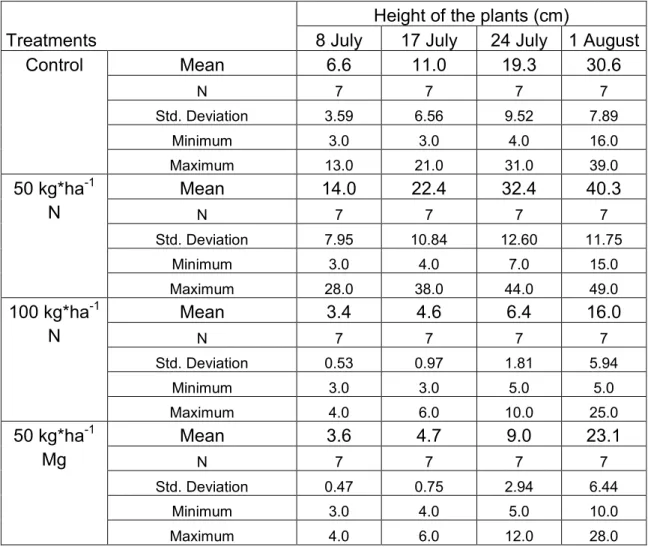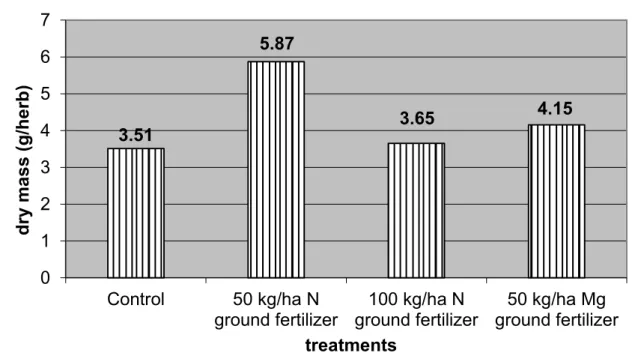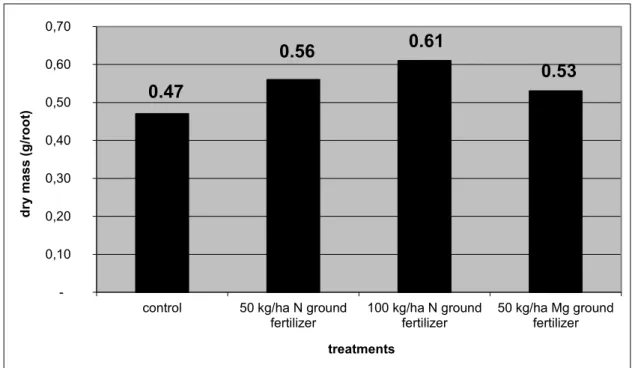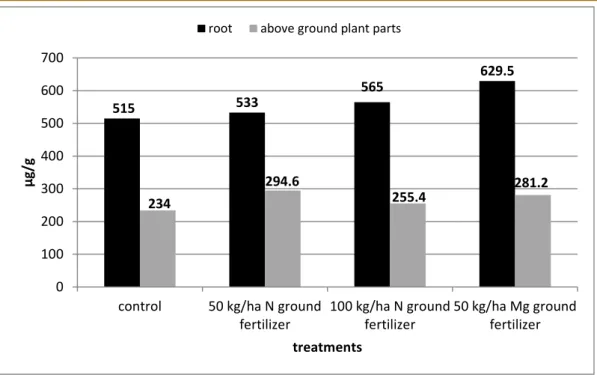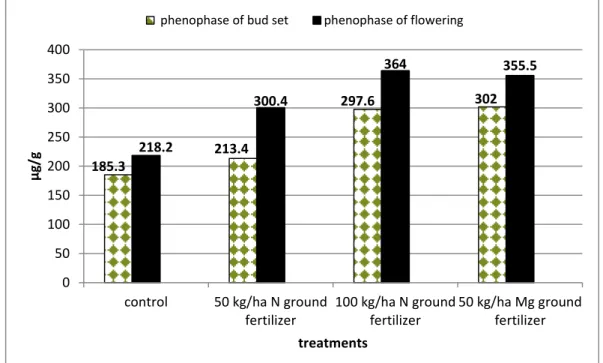EFFECT OF NITROGEN AND MAGNESIUM NUTRITION ON INDIAN TOBACCO ( LOBELIA INFLATA L.)
AZ INDIÁN DOHÁNYON ( LOBELIA INFLATA L.) VÉGZETT NITROGÉN ÉS MAGNÉZIUM KÍSÉRLETI EREDMÉNYEK
Viktor József VOJNICH1*, Ákos MÁTHÉ1, Éva SZŐKE2, Péter BÁNYAI2, Ferenc KAJDI1 and Richárd GAÁL1
1Faculty of Agriculture and Food Sciences, Institute of Environmental Sciences,University of West Hungary, Hungary, Vár 2, 9200 Mosonmagyaróvár, *correspondence vojnichv@mtk.nyme.hu
2Faculty of Pharmacy, Department of Pharmacognosy, Semmelweis University, Hungary, Üllői út 26, 1085 Budapest
ABSTRACT
Lobelia inflata L. a native North- American species is reported to possess
pharmaceutically significant properties. Our experiments aimed at introducing this species to Hungary and implemented in randomized blocks with 4 repetitions, indicate the favourable effects of Mg-fertilization. Based on our results, it can be estimated that under the influence of Mg treatment an established population of Indian tobacco can produce some 3.2 kg*ha-1 total alkaloids.
Keywords: Indian tobacco (Lobelia inflata L.), Nitrogen and Magnesium treatment, HPLC, piperidine alkaloids, lobeline.
KIVONAT
Az indián dohány egy Észak-Amerikában honos faj, gyógyászati szempontból jelentős gyógynövény. Kísérletünk randomizált blokk elrendezésben, négy ismétlésben történt, és mutatja a Mg-kezelés kedvező hatását. Eredményeink összhangban vannak az előzetes in vivo és in vitro kísérletekkel. Végső konklúziója az eredményeknek, hogy becslés szerint a magnézium kezelés hatására az indián dohány hektáronként körülbelül 3,2 kg összalkaloidot képes termelni.
Kulcsszavak: indián dohány (Lobelia inflata L.), Nitrogén és Magnézium kezelés, HPLC, piperidin alkaloidok, lobelin
INTRODUCTION
Indian tobacco, a native North American species is a useful medicinal plant that can be introduced in Hungary. Lobelia inflata L. belongs to the order Campanulales, to the family Lobeliaceae. Indian tobacco is an annual plant (Kelly, 1992) but biennial populations can be found, too.
The herb contains several piperidine skeleton alkaloids (Felpin and Lebreton, 2004;
Kursinszki et al., 2008). Its main alkaloid is the lobeline that due to its stimulating
(Vermeulen, 1994). It is also used in anti-smoking preparations because it is a
competitive nicotinic antagonist (Szőke and Máthé, 2007; Takács-Hájos et al., 2007).
The significance of lobeline has increased in recent years due to its activity on the central nervous system. Recently, significant amounts of polyacetylene compounds have also been isolated from the plant (lobetyol, lobetolin and lobetyolin) (Felpin and Lebreton, 2004).
The aim of this project was to examine the effect of magnesium and nitrogen fertilisation on both biomass and alkaloid production of L. inflata in Hungary.
MATERIAL AND METHOD
The open field trials were carried out in 2010 at the University of West-Hungary, Faculty of Agriculture and Food Sciences. N- and Mg- fertilizers were applied in the form of ground fertilizers, as follows: untreated (control), 50 kg*ha-1 N -, 100 kg*ha-1 N ground fertilizers and 50 kg*ha-1 Mg ground fertilizer. No other fertilizers were applied. Soil analytical values: pH 7.12; humus 3.08 m/m%; Mg 310 mg*kg-1; NO2- NO3-N 20.1 mg*kg-1; K2O 518 mg*kg-1; P2O5 358 mg*kg-1. An extended soil analysis was carried out according to standard methods of UIS Ungarn laboratory (Hungary, Mosonmagyaróvár).
Experimental plants were propagated by seeding and subsequent transplant raising in glasshouse controlled by a fully automatic energy-umbrella.
Seeding took place in glasshouse on 15th of January 2010. Seedlings were
transplanted to multi-cellular transplant raising trays, between 1st of May and 5th of May and grown for one and a half month.
Mg (2%) - and N (34%) fertilizers were spread onto the soil surface, one day prior to transplanting. Date of transplanting: 15th June, 2010.
The number of plants per plot was 27. The measurement of plot was 1.2 m2. The experimental design was a randomized blocks with 4 repetitions. It should be noted that due the significant damages caused by Spanish slug (Arion vulgaris) in the first two days, major problems were observed in the care of the plantation. As a result, several plants had to be substituted. Mechanical weed control was applied in terms of plant care. No chemicals or herbicides were applied.
Plant height (cm) leaf length and width were four times: 8 July, 17 July, 24 July and 1st of August, and fresh biomass (g) on 5th August. In each treatment 7 plants were measured. The statistical analysis was accomplished with SPSS v19 software. The first harvest took place on 5-6th of August, when the biomass was recorded.
Following harvest, the plants were dried in a shaded and well-ventilated greenhouse.
The dry weight determination was 30th of August. The flowering phenophase was observed in the period July between September.
Alkaloid Extraction: Lobelia inflata L. (1 g), dried and powdered, was extracted with 1x20 ml, and 2x15 ml of 0.1 N HCl-methanol (1:1, v/v) by sonication for 3x10 minute.
After centrifugation and filtration the methanol was evaporated off and the remaining aqueous phase was made up to a stock solution with 0.1 N HCl. Samples of this solution were purified by solid-phase extraction (SPE) for the quantitative HPLC (High Performance Liquid Chromatography) determinations.
The total alkaloid content was determined by a spectrophotometric method elaborated by Mahmoud and El-Masry (1980) and modified by Krajewska (1986).
The lobeline content was determined by HPLC method by Yonemitsu, et al. (1990) and modified by Bálványos, et al. (2001) and Kursinszki, et al. (2008).
RESULTS AND DISCUSSION
References in the special literature on the mineral nutrition of Lobelia inflata L. are scarce, although it is one of the basic factors for the successful production of this species.
Some information is available from in vitro hairy root experiments by Bálványos (2002), according to whom among the various nutrients tried (Mg, Ca, Na, N), Mg has proved to be most effective in increasing both the dry biomass and lobeline content.
In order to control the validity of these observations for the open field conditions, our nutrition investigations were aimed at the study of the effect of Mg, N-nutrition.
Table 1. Influence of N- and Mg-fertilization on the growth (height in cm) of Indian tobacco (Lobelia inflata) in the vegetation period (2010).
Táblázat 1. A N- és a Mg- tápanyagellátás hatása az indián dohány (Lobelia inflata) növekedésére (magasság cm-ben), a vegetációs időszakban (2010).
Treatments
Height of the plants (cm)
8 July 17 July 24 July 1 August
Control Mean 6.6 11.0 19.3 30.6
N 7 7 7 7
Std. Deviation 3.59 6.56 9.52 7.89
Minimum 3.0 3.0 4.0 16.0
Maximum 13.0 21.0 31.0 39.0
50 kg*ha-1 N
Mean 14.0 22.4 32.4 40.3
N 7 7 7 7
Std. Deviation 7.95 10.84 12.60 11.75
Minimum 3.0 4.0 7.0 15.0
Maximum 28.0 38.0 44.0 49.0
100 kg*ha-1 N
Mean 3.4 4.6 6.4 16.0
N 7 7 7 7
Std. Deviation 0.53 0.97 1.81 5.94
Minimum 3.0 3.0 5.0 5.0
Maximum 4.0 6.0 10.0 25.0
50 kg*ha-1 Mg
Mean 3.6 4.7 9.0 23.1
N 7 7 7 7
Std. Deviation 0.47 0.75 2.94 6.44
Minimum 3.0 4.0 5.0 10.0
Maximum 4.0 6.0 12.0 28.0
Table 1 and Table 2 summarize the effect of fertilizers on plant growth. As expected and shown by the analysis of variance, as well as Tukey test, the growth parameters show significantly different values for plant height. A similar tendency was observed in the case of plant fresh weight (Table 3 and Table 4), where 50 kg*ha-1 N brought
Table 2. Tukey HSD test of Indian tobacco (Lobelia inflata). Values of the four treatments were measured four times, in 2010. (Parameter: plant height) Táblázat 2. A Tukey HSD próba értéke az indián dohány (Lobelia inflata)
tápanyagellátásakor (4 kezelés, 4 mérés értékei) 2010-ben. (Paraméter: növény magasság)
Date of measuremens
Treatments (A)
Treatments (B)
Mean Difference
(A-B)
Std.
Error
Sig. level
8 July Control 50 kg*ha-1 N -7.4286 2.3421 0.020 * 100 kg*ha-1 N 3.1429 2.3421 0.546
n.s.
50 kg*ha-1 Mg 2.9286 2.3421 0.602 n.s.
17 July Control 50 kg*ha-1 N -11.4286 3.4032 0.013 * 100 kg*ha-1 N 6.4286 3.4032 0.259
n.s.
50 kg*ha-1 Mg 6.2857 3.4032 0.277 n.s.
24 July Control 50 kg*ha-1 N -13.1429 4.3217 0.027 * 100 kg*ha-1 N 12.8571 4.3217 0.031 * 50 kg*ha-1 Mg 10.2857 4.3217 0.108
n.s.
1 August Control 50 kg*ha-1 N -9.7143 4.4508 0.157 n.s.
100 kg*ha-1 N 14.5714 4.4508 0.016 * 50 kg*ha-1 Mg 7.4286 4.4508 0.361
n.s.
* The mean difference is significant at the 0.1 level.
n.s. = not significant
* A szignifikancia értéke 0,1.
n.s. = nem szignifikáns
Table 3. Influence of fertilization on the fresh weight of Indian tobacco (Lobelia inflata) measured on 5th of August in 2010.
Táblázat 3. Az indián dohány (Lobelia inflata) friss tömegének alakulása különböző tápanyagellátás hatására (2010. augusztus 5).
Treatments g/plant N Std. Deviation Minimum Maximum
Control 24.86 7 10.558 5 38
50 kg*ha-1 N 35.43 7 8.162 20 44
100 kg*ha-1 N 34.86 7 12.171 14 52
50 kg*ha-1 Mg 33.57 7 8.243 25 49
Table 4. Tukey HSD test for fresh weight of Indian tobacco (Lobelia inflata) measured on 5th of August, 2010.
Táblázat 4. Az indián dohány (Lobelia inflata) friss tömeg értékei a Tukey HSD próba mérésekor. (2010. augusztus 5)
Treatment (A)
Treatments (B)
Mean Difference (A-B)
Std. Error Sig.level Control 50 kg*ha-1 N -10.571 5.306 0.219 n.s.
100 kg*ha-1 N -10.000 5.306 0.261 n.s.
50 kg*ha-1 Mg -8.714 5.306 0.375 n.s.
* The mean difference is significant at the 0.1 level.
n.s. = not significant
* A szignifikancia értéke 0,1.
n.s. = nem szignifikáns
Figure 1 illustrates the dry biomass values recorded for above ground plant parts, at the flowering phenophase that was highest in the 50 kg*ha-1 N-treatment followed by the 50 kg*ha-1 Mg-, 100 kg*ha-1 N-treatments. The lowest values were recorded for the control. Remarkably, nitrogen had a positive influence also on root development, but in a slightly different way. The two N-treatments gave the highest root dry
biomass values (Figure 2), however remarkably, in this case the highest mean values were not resulted by the 50 kg*ha-1, but the 100 kg*ha-1 N treatment.
3.51
5.87
3.65 4.15
0 1 2 3 4 5 6 7
Control 50 kg/ha N ground fertilizer
100 kg/ha N ground fertilizer
50 kg/ha Mg ground fertilizer
dry mass (g/herb)
treatments
Figure 1. Dry biomass production (g/plant) of above ground plant parts of Indian tobacco (Lobelia inflata) at the flowering phenophase in 2010.
Ábra 1. Az indián dohány (Lobelia inflata) föld feletti rész száraz biomassza értéke (g/növény), a virágzás fenofázisban (2010).
0.47
0.56 0.61
0.53
- 0,10 0,20 0,30 0,40 0,50 0,60 0,70
control 50 kg/ha N ground fertilizer
100 kg/ha N ground fertilizer
50 kg/ha Mg ground fertilizer
dry mass (g/root)
treatments
Figure 2. Dry biomass production of roots (g/plant) of Indian tobacco (Lobelia inflata), at the flowering phenophase in 2010.
Ábra 2. Az indián dohány (Lobelia inflata) gyökér száraz biomassza produkciója (g/növény), a virágzó fenofázisban (2010).
The alkaloid production of above ground organs was also favourably influenced by the Mg-fertilization. As shown in Figure 3 the lobeline content of above ground plant parts varied between 234 µg*g-1 and 294.6 µg*g-1. Lowest values were recorded in the non-fertilized control (234 µg*g-1), whereas a 20.1 % increment was observed in the 50 kg*ha-1 Mg ground fertilizer treatment: 281.2 µg*g-1. As regards the effect of N- fertilization, the response of alkaloid production was similarly favourable. In the 50 kg*ha-1 N ground fertilizer treatment: 294.6 µg*g-1 alkaloid production was recorded.
Remarkably the application of 100 kg*ha-1 N ground fertilizer produced lower values with a mean alkaloid content of 255.4 µg*g-1 (9.1%). The lobeline content of above ground plant parts in the 50 kg*ha-1 Mg ground fertilizer treatment was lower than in the 50 kg*ha-1 N ground fertilizer treatment. The total alkaloid content of plants in the 50 kg*ha-1 Mg ground fertilizer treatment was (0.4%) higher than in the 50 kg*ha-1 N ground fertilizer treatment.
515 533
565
629.5
234
294.6
255.4
281.2
0 100 200 300 400 500 600 700
control 50 kg/ha N ground fertilizer
100 kg/ha N ground fertilizer
50 kg/ha Mg ground fertilizer
µg/g
treatments root above ground plant parts
Figure 3. Lobeline content (µg*g-1) of root and above ground plant parts.
Ábra 3. Lobelin tartalom (µg*g-1) a gyökér és a föld feletti részben.
The lobeline content of roots was increased by Mg-application (22.2%) from 515 µg*g-1 to 629.5 µg*g-1(Figure 3). Similar values for the 50 kg*ha-1 N ground fertilizer treatment were: 533 µg*g-1, 100 kg*ha-1 N ground fertilizer treatment: 565 µg*g-1. The lobeline content at the phenophase of bud set: control 185.3 µg*g-1, 50 kg*ha-1 N ground fertilizer: 213.4 µg*g-1, 100 kg*ha-1 N ground fertilizer: 297.6 µg*g-1, 50 kg*ha-
1 Mg ground fertilizer: 302 µg*g-1. The lobeline content at the phenophase of flowering: control 218.2 µg*g-1, 50 kg*ha-1 N ground fertilizer: 300.4 µg*g-1, 100 kg*ha-1 N ground fertilizer: 364 µg*g-1, 50 kg*ha-1 Mg ground fertilizer: 355.5 µg*g-1 (Figure 4).
185.3
213.4
297.6 302
218.2
300.4
364 355.5
0 50 100 150 200 250 300 350 400
control 50 kg/ha N ground fertilizer
100 kg/ha N ground fertilizer
50 kg/ha Mg ground fertilizer
µg/g
treatments
phenophase of bud set phenophase of flowering
Figure 4. Lobeline content (µg*g-1) at the phenophase of bud set and flowering phenophase.
Ábra 4. Lobelin tartalom (µg*g-1) a bimbós- és a virágzó fenofázisban.
CONCLUSIONS
In the field trials of L. inflata we have established the favourable effect of fertilization.
The best results were obtained under the influence of 50 kg*ha-1 Magnesium, applied as ground fertilizer. Based on our results, it can be postulated that the right choice of Mg-fertilization can exert a favourable effect on both biomass and alkaloid
production. We estimate that an established population of L. inflata can produce some 3.2 kg*ha-1 total alkaloids.
As a result of fertilization, the highest lobeline content of the roots of Lobelia inflata L.
increased by 3.5-22.2 % (629.5 µg*g-1 - 50 kg*ha-1 Mg ground fertilizer treatment) exceeding by 3.5% the control values.
The lobeline content of above ground plant parts amounted to 281.1 µg*g-1 (in the 50 kg*ha-1 Mg ground fertilizer treatment) that exceeded by 20.1% the value of the control.
The lobeline content of above ground plant parts in the 50 kg*ha-1 Mg ground fertilizer treatment was lower than in the 50 kg*ha-1 N ground fertilizer treatment, although the total alkaloid content in the 50 kg*ha-1 Mg ground fertilizer treatment exceeded (0.4%) that of the 50 kg*ha-1 N ground fertilizer treatment.
The highest lobeline content at the phenophase of bud set was 302 µg*g-1 (50 kg*ha-
1 Mg ground fertilizer treatment) which is 61.3% higher than the control.
The highest lobeline content at the phenophase of flowering was 364 µg*g-1 (100 kg*ha-1 N ground fertilizer) which is 60% higher than the control.
The results indicate the favourable effect of Mg-fertilization and are in harmony with our previous experiments. The lobeline content values of plants treated with Mg, determined by HPLC, were the highest in all treatments but for the 50 kg*ha-1 N- treatment (above ground plant parts).
ACKNOWLEDGEMENTS
This work was supported by Semmelweis University, Department of Pharmacognosy in Budapest. Thanks for the laboratory research worker for Lenke Tóth. The support of GVOP 3.1.1.-2004-05-0309/3.0 is gratefully acknowledged.
REFERENCES
Bálványos, I., (2002): Studies on the growth and secondary metabilite production of Lobelia inflata L. hairy root cultures. PhD thesis, Budapest.
Bálványos, I., Kursinszki, L., Szőke, É., (2001) The effect of plant growth regulators on biomass formation and lobeline production of Lobelia inflata L. hairy root cultures. Kluwer Academic Publishers, Printed in the Netherlands, Plant Growth Regulation, 34, 339-345.
Felpin, F.-X., Lebreton, J., (2004) History, chemistry and biology of alkaloids from Lobelia inflata. Tetrahedron, 60, 10127-10153.
Kelly, C. A., (1992) Reproductive phenology in Lobelia inflata L. (Lobeliaceae) and their enviromental control. Americana Journal of Botany, 79, 1126-1133.
Krajewska, A., (1986) The effect of new type of growth regulators on the Lobelia inflata L. tissue cultures (in Hungarian). PhD thesis, Budapest.
Kursinszki, L., Ludányi, K., Szőke, É., (2008) LC-DAD and LC-MS-MS Analysis of Piperidine Alkaloids of Lobelia inflata L. (in vitro and in vivo). Chromatographia, 68, 27-33.
Mahmoud, Z. F., El-Masry, S., (1980) Colorimetric determination of lobeline and total alkaloids in Lobelia and its preparations. Sci. Pharm., 48, 365-369.
Szőke, É., Máthé, Á. (2007). GVOP 3.1.1.-2004-05-0309/3.0 report of research.
NKTH, Budapest.
Takács-Hájos, M., Szabó, L., Rácz, I-né., Máthé, Á., Szőke, É. (2007) The effect of Mg-leaf fertilization on Quality parameters of some horticultural species. Cereal Research Communications, 35 (2), 1181-1184.
Vermeulen, F., (1994) Concordant Materia Medica. Merlijn Publishers, Haarlem.
Yonemitsu, H., Shimomura, K., Satake, M., Mochida, S., Tanaka, M., Endo, T., Kaji, A., (1990) Lobeline production by hairy root culture of Lobelia inflata L. Plant Cell Report, 9, 307-310.
